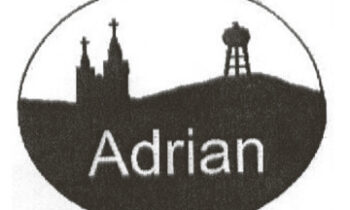By Deb Kroon
Review Staff Writer
Some people are lucky to be in the right place at the right time. This was the case for Corey Shorter, son of Pat and Rashelle Shorter of rural Worthington, and grandson of Don and Carole Shorter of Adrian. It started when Corey was in high school. His plans for the future were to attend the Mitchell Tech power line program. One evening during a shift at TSC, in Worthington, a couple of guys came in to buy mats for a work trailer. Corey struck up a conversation with Charlie (one of the guys) and learned that they were in the area working on power lines from a helicopter. Charlie invited Corey to come out to the site and see what they did. Corey was introduced to Air2.
Time passed. Corey finished school and started to work. He worked on power line construction from the ground for a couple of different companies and that just didn’t fit him. He returned home and worked with his father Pat for a while. Pat owns a body shop in Worthington. He encouraged Corey to take a chance and call Air2. Corey took his dad’s advice and made the call. He made initial contact with the office of Air2, located in Timonium, Maryland. Corey didn’t hear from them, but he continued to call until he finally received an answer. When the call came from Maryland, on the other end was a man named Smokey. He talked with Corey for a while, inquiring about his interest in Air2. Smokey booked a flight into Sioux Falls, SD for the next day. Corey met up with Smokey for dinner and within a few hours, Corey was offered a job.
Air2 is a PLH Group company. PLH Group is a full service construction and speciality construction contractor that serves electric power lines, pipelines, oil fields, electrical services and industrial markets. They are all about energy. Air2 is a speciality helicopter assisted utility company that serves utilities and contractors by giving the companies access to difficult or sensitive areas with minimal environmental impact and right of way intrusion. They do new construction as well as maintain and repair existing power lines. Air2 is a company of about 80 people, consisting of pilots, mechanics and lineman as well as office support staff. They have 9 helicopters that serve states all over the US, but most of the time they work within the South from Florida to Texas.
After Corey joined the team, he went to Denton, TX to begin his training. In 2012, the PLH Group launched an Apprenticeship Program. Air2 employees who take part in the program do so as line maintainers, focusing on elevated work, transmission, transformers, hot-line work, power delivery equipment and crew leadership, all with an emphasis on safety and protection. Successful completion of the program requires 2,000 hours of documented on-the-job training plus 144 hours of classroom education each year for four years at Northwest Lineman College in Denton.
Corey was with Air2 for approximately two months when Hurricane Harvey struck the US. He traveled with a crew consisting of three linemen, a truck and a trailer to Beaumont, TX where they met up with the pilot, mechanic and their helicopter. This crew was responsible for restoring power to this town that had been decimated by the hurricane. They spent 45 days in Beaumont. They lived in second floor hotel rooms that had no water or electricity, and the food they ate was brought in. Conditions were terrible. In the first seven days they were in Beaumont, they put in 121 hours. After a long, hot day, when a shower would be great, they got to use a couple of bottles of water to rinse off with. Corey’s introduction to aerial line work was rough, but he has thrived on the challenges.
After being with Air2 for about 15 months, Corey and his crew mates came to Southwest MN for a hitch (a job). Excel Energy hired them to replace and repair wires and do some maintenance on the power lines that run along Interstate 90 from just west of Worthington to Luverne. Two Air2 helicopters and crews came to the area around the beginning of July. For the next 51 days, you could see helicopters and crew members flying back and forth working on the lines,
The turbo prop helicopters are small. The maximum they hold is four people, but that is not the norm for Air2. Usually in the bird is the pilot and two lineman and their equipment. One man rides on the skid of the helicopter and one man rides inside, handing tools as needed. One big advantage for Corey is his 6’5 frame. His height and his long arms give the pilot more room to maneuver while working. Corey sits on the skid and is able to lean over and complete his work. He is dressed from head to toe in fire rated clothing-gloves, boots, jacket, pants and sometimes if they are working on ‘hot’ lines, they even wear a mask. He is connected to the pole and the helicopter. He has two lines that are attached to him and the pole and a break-away line attached to the bird. These guys are always connected to each other through radio and blue tooth as well. Corey has learned to trust his equipment and his crew members. He uses an exact procedure to hook up to the pole, one line at a time and he unhooks by following the same procedure backwards. He is always hooked by multiple lines. Although an aerial lineman is one of the top ten most dangerous jobs, he is less likely to get hurt by a fall than someone on the ground climbing a pole. Everything the Air2 crews work with are built and done with an exact purpose. The poles are built with hooks up the poles and on the arms. These are for the express purpose of securing the lineman while working. Safety is always first.
From Luverne to Adrian, the non-conductive spacers were replaced and maintenance was done on the lines by one crew. The second crew worked from Adrian to mile marker 36 installing new lines and removing the old. You’ll notice these lines are now twisted. The twisted lines are able to handle the wind better than the straight lines and are made to shed ice faster. They also contain fiber optic lines within them. The lines are strung in two mile increments. The new lines are attached with lead lines (wire rope) to the existing lines and pulled (called a side pull) by the helicopter until they are in place.
The pilot is totally in charge of the operation. He is constantly connected to programs that monitor the weather. If he deems it too windy, they don’t go up. If there is any report of lightening in the area, they are grounded. One of the days they were here, the helicopter didn’t ‘feel right’ to the pilot, so they didn’t go up until the mechanic had it fixed. The mechanic is always on the ground. The main part of his job begins when the bird lands for the day.
In the 15 months Corey has worked for Air2, he has worked in New Orleans, the Louisiana swamps, Atlanta, and of course Texas. “New Orleans is a big, very busy city,” Corey said. “There is lots of traffic. Officials shut down the road Air2 was working over because of the distraction.” They didn’t want accidents due to distracted driving. Even though there were officers posted near them, there were still gawkers. It is definitely not something you see every day.
In the Louisiana swamps, because it’s nearly impossible to get poles and equipment in by ground, a sky crane was used to set 200 foot poles down on pedestals that were set in the swamps. That helicopter was so big, it took three guys to run it, 2 pilots and someone to lower the poles. The wind from the sky crane’s blades is so strong, a person literally can not stand up. Air2 can get into places that others can’t.






